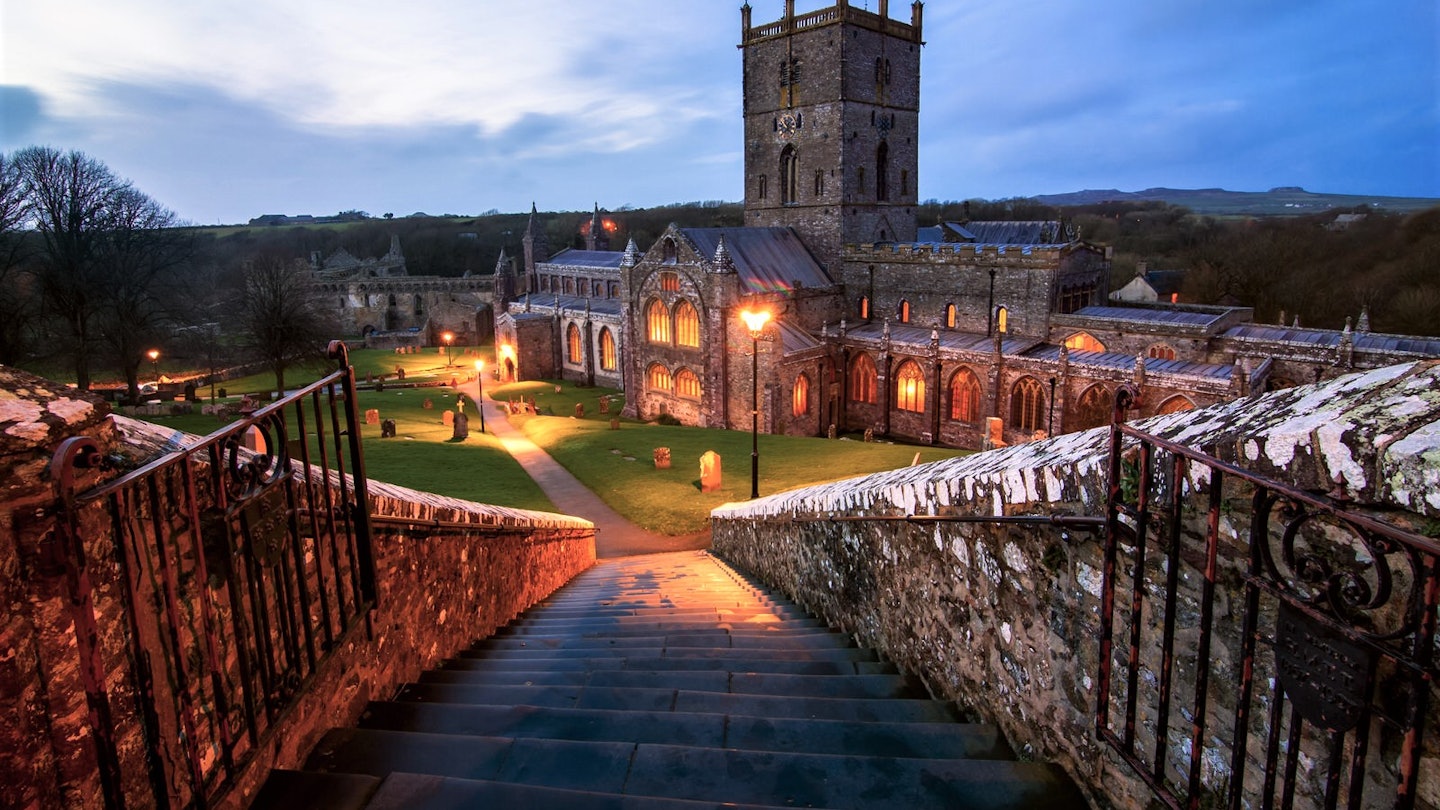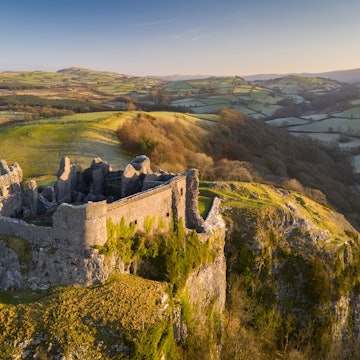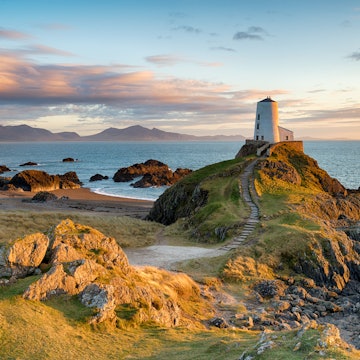

The cathedral in St Davids is the resting place of Wales' patron saint © joe daniel price / Getty Images
Wales’ history is packed full of legends, both fictional and factual, and despite the years that have passed, they are not out of reach for modern visitors. Discover the heroes, creatures and magnificent landscapes that shaped the country, its people and its traditions by visiting these special sites.

St Davids, Pembrokeshire – small city, big saint
The UK’s smallest city is named after the patron saint of Wales, St David. Back in the 6th century, Dewi Sant, as he’s known in Welsh, founded monasteries across his homeland and France, including one in his local community.
He was born to a lady named Non, who also became a saint, and his birthplace is marked by the remains of St Non’s Chapel, easily reached on a 20-minute walk from St Davids centre.
Back in town, a spectacular cathedral, which has been a place of pilgrimage for hundreds of years, holds the saint’s remains and was built in the 12th century alongside his monastery. It’s said that two pilgrimages to the cathedral are equal to one pilgrimage to Rome, and it brings thousands of visitors from around the world to the tiny city every year – not to mention Welsh visitors who want to honour their saint in his final resting place.

Dinas Emrys, Gwynedd – here be dragons
Y Ddraig Goch, the famous red dragon of Wales, is more than a quirky feature on the country's flag. A tale told by a Welsh monk named Nennius that dates back to around AD 769 is thought to reveal the dragon’s origins.
The story goes that a Celtic king named Vortigern attempted to build a fortress on a mountainous area of land now known as Dinas Emrys, which overlooks Llyn Dinas lake in Snowdonia. After the walls fell down multiple times, a boy wizard named Merlin told Vortigern that there was a pool underneath the mountain in which a red dragon and a white dragon were fighting, their battles causing the walls to crumble.
What happened next is a bit muddled because of various interpretations of the stories. One version says that Vortigern released the dragons who fought until the white dragon (representing the encroaching Anglo-Saxons) fled, leaving the red dragon (representing the Welsh) victorious and able to return in peace to its underground lair. Another version also has the red dragon winning and sees this as heralding the arrival of King Arthur (Merlin’s associate). Yet another variation, told in The Mabinogion (a book of early Welsh stories that should be top of the list for anyone with an interest in Welsh myths and legends), focuses instead on where the dragons came from.
Although the tale is fantastical, an archaeological dig in 1945 did uncover fortifications that date back to Vortigern’s time. To come to your own conclusion, and possibly feel some dragon rumblings, visit Dinas Emrys yourself via the National Trust Craflwyn Farm.

Beddgelert, Gwynedd – good dog
Translating as ‘Gelert’s grave’, Beddgelert in wild Snowdonia has become famous for an often-believed myth that the village is named after Gelert, Prince Llywelyn the Great’s dog. Although the Snowdonia connection was actually made up by a local landlord a couple of centuries ago to boost tourism, facts shouldn’t get in the way of a good legend so here’s how the tale goes.
One day, Prince Llewelyn went for a walk, leaving his baby son and dog Gelert at home. He returned to find an upturned cradle, his boy missing and Gelert covered in blood. Assuming Gelert had killed the baby, Llewelyn took his sword to the dog, only then to hear the baby crying nearby. Gelert hadn’t killed the baby; instead, he’d killed a wolf that had tried to steal the prince’s son. Llewelyn was grief-stricken at his mistake and held a ceremony to bury the faithful Gelert in a plot nearby.
Of course, this is all a tall tale, but you can visit ‘Gelert’s grave’ today in the village, and even if the dramatic story isn’t true, pretty Beddgelert is still well worth a visit thanks to its old, dark-stone houses, arches over rivers and access to multiple routes that head up Snowdon.

Llanddwyn Island, Anglesey – lost love on Llanddwyn
Wonderfully romantic in story and setting, Llanddwyn Island (Ynys Llanddwyn) is home to Church of St Dwynwen, Wales’ patron saint of lovers. Word has it that young Dwynwen was due to marry a man named Dafodrill, but their marriage didn’t happen (the reasons differ depending on the storyteller but possibly because her father forbade it). A holy being (God, an angel – again, versions differ) helped Dwynwen by freezing Dafodrill and giving her three wishes. She asked for Dafodrill to be thawed, for true lovers to be able to be together and for her to be able to live alone on Llanddwyn on Anglesey for the rest of her life.
You can access her small, tidal-island home from Anglesey’s west coast via the Anglesey Coastal Path. The island is part of the Newborough Warren National Nature Reserve which has over 10 miles of paths winding over dunes, saltmarsh, sand flats, a forest and a beach. The nearest car park to the island is just a mile away, and a direct route from there will let you take in the ruins of St Dwynwen’s Church and views of the Menai Strait and the Welsh mainland. For extra romance, stay in nearby Château Rhianfa, a hotel that looks straight out of a fairytale.

Llyn y Fan Fach – a lady, a lake and more lost love
This remote lake in Carmarthenshire is a relic of the area’s glacial past, sitting in a dip below a steeply sloped hill topped by the Bannau Sir Gaer ridge. But that’s enough geology and geography.
The myth connected with the area is that of a farmer named Gwyn, who fell in love with a water fairy known as the Lady of the Lake. He proposed to her and she accepted, but only as long as he promised never to strike her three times. One day, while they were living happily with their three sons, Gwyn struck her three times in a playful manner – and that was the last time Gwyn saw her. The Lady of the Lake returned to her watery home, just as she’d warned her husband she would.
Luckily, that’s not quite the end of the tale. A somewhat happier version involves the Lady of the Lake continuing to make appearances to her sons after the marriage was over, teaching them how to heal using herbs and plants from the natural world. The boys are known in literature as the first Physicians of Myddfai, who passed their skills on to many others.
The lake lies within the Brecon Beacons National Park and you can get there along the path from the Llyn y Fan Fach car park: it takes about 45 minutes, it’s rather steep and can be muddy, so wear walking boots. Or, if you want to see the lake from above and get a better sense of how the land around it has been naturally carved over the centuries, walk along the exposed Bannau Sir Gaer ridge.

Three other places for tapping into Welsh legends
National Library of Wales, Aberystwyth
One of six legal deposit libraries in the UK and Ireland (meaning it holds a copy of every publication produced), this impressive library gives the public access to the country’s history, heritage and culture via its enormous collection. There are guided tours every week, as well as exhibitions, talks and events.
St Fagans National History Museum, Cardiff
St Fagans is a museum of Welsh life from the past and present. Walk around noteworthy buildings from across Wales that have been transported brick by brick to the open-air collection, meet staff role-playing locals from bygone times, and learn about Welsh history through artefacts and storytelling.
Laugharne, Carmarthenshire
Not all legends are made up – take Dylan Thomas, the famous Welsh writer, for example. He called the rugged coastal town of Laugharne home, and it’s where he wrote poems and screenplays, drank copious amounts of alcohol and sought inspiration for his work. You can visit his writing shed and boathouse, both of which offer the chance to learn more about the (real) legendary literary figure and take in views of the choppy River Taf.
Make the most of your travel with sightseeing tours and activities from our trusted partners.
https://shop.lonelyplanet.com/products/wales-travel-guide-6
















